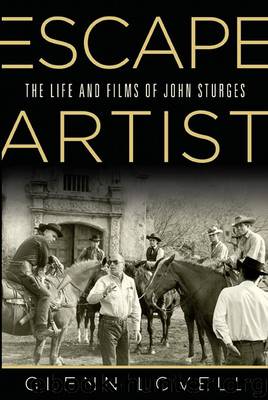Escape Artist: The Life and Films of John Sturges by Glenn Lovell

Author:Glenn Lovell [Lovell, Glenn]
Language: eng
Format: epub
ISBN: 9780299228309
Google: 06gLAQAAMAAJ
Publisher: The University of Wisconsin Press
Published: 2007-12-31T16:00:00+00:00
10
The Rat Trap
It sounded like a contradiction, given their antithetical work ethics, but John Sturges was seduced as much by Frank Sinatra’s bad-boy image as his talent. “Frank never took anything off anybody and I admired the hell out of that. Maybe because I was like that myself, but in a less out there way.” Their different notions of machismo, what it meant to be a “man’s man,” brought them together twice—first for the World War II melodrama Never So Few and then, two years later, for an ill-conceived Western remake of Gunga Din called Sergeants 3.
“Sturges and Sinatra? They were a weird team,” agreed Robert Relyea, the director’s assistant. “John was so square we used to say he was cubed; everything had to be proper and straight. If you held your cards out, John wouldn’t look at them. He was one of those kinds of guys.” The entertainer, on the other hand, could be mischievous and inconsiderate. “What can you say about Frank?” said actress Ruta Lee. “He liked to play—and do things on ‘Frank time.’” Added Henry Silva, “There were fireworks on Sergeants 3, but most of the time Frank respected the hell out of Sturges because Sturges was so well prepared.”
With the critical acclaim of From Here to Eternity and The Man with the Golden Arm, Sinatra had evolved into a credible dramatic lead and reliable box-office draw. But it was well known that, for all his ambition, he had trouble concentrating on a project very long and was always anxious to move on to the next thing, be it a recording session, a club engagement, or another movie. “If Frank said, ‘I won’t work beyond such-and-such date,’” recalled Relyea, “that was it—you had better adjust your calendar.” Not surprisingly, then, he gravitated to filmmakers who got things done quickly and efficiently. When MGM optioned Tom T. Chamales’s best-selling Never So Few—about Kachin rebels trained by American and British O.S.S. operatives in the jungles of northern Burma—and announced Sinatra as Captain Tom Reynolds, the lead, Sturges’s name came up. Sinatra liked the idea: He was a fan of Bad Day at Black Rock and The Old Man and the Sea. But he needed reassurance because, at least initially, the project would mean a trip to remote, potentially dangerous locations. He called Spencer Tracy, and Tracy confirmed that Sturges was all right—“a no-bull kind of guy.”
“Frank,” explained Sturges, “had no tolerance for people in the industry because they had steered him wrong so often, and he had made a lot of pictures he thought were crap because he needed the money to pay his income tax…. On that first picture, I had no trouble with him. He had heard from Spence that I was the kind of director he’d get along with.”
Sturges accepted the project provided he could retain members of his team, including Millard Kaufman and Ferris Webster; shoot on location in the jungles of Burma and Ceylon, where David Lean had shot Bridge on the River Kwai; and, most important, have Sinatra’s undivided attention.
Download
This site does not store any files on its server. We only index and link to content provided by other sites. Please contact the content providers to delete copyright contents if any and email us, we'll remove relevant links or contents immediately.
Aircraft Design of WWII: A Sketchbook by Lockheed Aircraft Corporation(32215)
The Great Music City by Andrea Baker(31359)
Call Me by Your Name by André Aciman(20374)
The Secret History by Donna Tartt(18849)
The Art of Boudoir Photography: How to Create Stunning Photographs of Women by Christa Meola(18537)
Shoot Sexy by Ryan Armbrust(17659)
Plagued by Fire by Paul Hendrickson(17333)
Portrait Mastery in Black & White: Learn the Signature Style of a Legendary Photographer by Tim Kelly(16953)
Adobe Camera Raw For Digital Photographers Only by Rob Sheppard(16906)
Photographically Speaking: A Deeper Look at Creating Stronger Images (Eva Spring's Library) by David duChemin(16623)
Ready Player One by Cline Ernest(14525)
Pimp by Iceberg Slim(14395)
Bombshells: Glamour Girls of a Lifetime by Sullivan Steve(13976)
The Goal (Off-Campus #4) by Elle Kennedy(13543)
Art Nude Photography Explained: How to Photograph and Understand Great Art Nude Images by Simon Walden(12975)
Kathy Andrews Collection by Kathy Andrews(11730)
The Priory of the Orange Tree by Samantha Shannon(8891)
The remains of the day by Kazuo Ishiguro(8825)
Thirteen Reasons Why by Jay Asher(8796)
